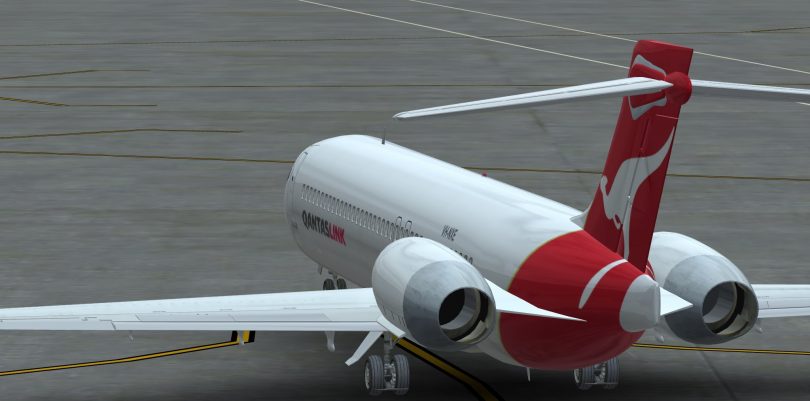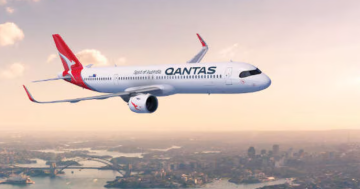
Qantas has hit back strongly at Canberra Airport over its campaign against flight cancellations. File photo.
Canberra Airport chief executive Stephen Byron may be bruised by his extraordinary public battle with Qantas but he has no regrets about shining a light on the airline’s high flight cancellation rate, particularly on the Canberra-Sydney run.
Mr Byron told The RiotACT that the Airport was committed to rebuilding the relationship with Qantas, its biggest customer, and it would now take a less public stand but he nonetheless took issue with Qantas’s claims that Canberra Airport was difficult to deal with and its charges too high.
Both Qantas Domestic chief executive Andrew David and Jetstar Group chief executive Gareth Evans had slammed the airport, with the latter saying it was not economic for the Qantas-owned low-cost carrier to fly there.
“We deal with airports around Australia and around the world, and none of them behave the way Canberra Airport does. It’s bizarre,” Mr David told Fairfax Media.
Qantas had also accused Canberra Airport of virtually holding a plane to ransom on the tarmac last year when it had to be diverted to the capital.
But Mr Byron said the relationship with Qantas had been a strong one for 19 of the past 20 years and the airline had only started lashing out when “we started complaining about the cancellation rates and wanting a better deal for our city and our airport.”
He may regret the damage to the relationship but “you can never regret standing up for Canberra, and standing up for the passengers that were being inconvenienced by the unacceptably high level of cancellations.”
Mr Byron denied that the Airport’s charges were too high, saying low-cost carrier Tiger Airways was making a go of its Canberra services and predicting that an international low-cost carrier would be flying into Canberra sooner than most think.
He said the airport had been working to bring Jetstar to Canberra for 14 years.
“Qantas and their executives will say to us clearly that Jetstar will not be coming to Canberra and it’s a decision of the board because it will cannibalise and reduce the profits Qantas makes out of the Canberra market,” Mr Byron said.
He said the Airport would not have been able to achieve what it had without excellent business relationships and it was committed to getting its relationship with Qantas back on track.
Mr Byron said the extent of the support from the public both surprised and worried him because it showed how big the problem actually was.
“I’ve had feedback from within Qantas, including Qantas engineering, that it was about time someone stood up for and brought to light the problems that were happening,” he said.
“I’ve had feedback from all of the highest levels of government that the cancellations were getting out of control. Every day I’ve had reaffirmation that this was a bigger problem than even I was aware of and it had to be fixed.”
The situation had improved but more still had to be done.
The latest figures for the Canberra to Sydney route showed 2.9 per cent of all flights were cancelled in March, with 3.5 per cent of Qantaslink flights cancelled. Virgin’s cancellation rate was 2.3 per cent.
Last October, 6.6 per cent of flights on the route were cancelled, with Qantas (12.5 per cent) and Qantaslink (8.8 per cent) taking the lion’s share. The national average was 1.3 per cent.
Qantas blamed the cancellations on a lack of available planes and crew.
“Ultimately the way Qantas can regain trust with the community is through the reliability of their service and I have no doubt that they are absolutely committed to that,” Mr Byron said.
“It’s a hugely powerful company that is committed to reliability of service and they have a capacity to fix this problem and I’m confident they will.”
On that tarmac incident last year, Mr Byron said the Qantas PR machine had only told half the story when it said a vehicle had blocked it until fees had been paid.
“What Qantas has NOT said about the 30 March 2017 event is that it was the last in a series of unannounced diversions by Qantas that posed a risk to other aircraft which had agreements in place and planned their flights on the basis of being able to divert to Canberra from Sydney Airport in an emergency. Sydney Airport receives around forty landings per hour,” Mr Byron said on LinkedIn.
“When it shuts down, due to winds or a thunderstorm, we cannot accommodate all of those aircraft – in fact, we can only park a maximum of five international aircraft on our Fairbairn apron. Qantas used to have one of these international diversion slot agreements with us but decided to let it lapse in 2015.
“… Unexpectedly, on 30 March 2017, a Qantas international 737 from Auckland diverted to Canberra without warning. We facilitated a prompt refuelling of the aircraft and started discussions between senior Canberra Airport and Qantas management about unauthorised diversions and, whilst payment was discussed (due to previous non-payments), it was not required at that time. While we did park an operations vehicle behind their plane, the aircraft was not ‘held hostage’–we were in full contact with the plane’s pilot and ground crew, so it was not a surprise. There was an eight-minute delay whilst discussions continued about these unauthorised diversions never happening again and the plane promptly departed and landed in the allotted slot time in Sydney.
“Within a week, a proper international diversion agreement, for one international aircraft only, was agreed amicably with Qantas and we both agreeing to put the incident behind us. We have not had any other issues with diversions.
“Going up against one of the largest and most powerful businesses in Australia is not easy. But fighting for a reliable service for travellers, Canberra and our visitors to Australia’s National Capital is the right thing to do. We will take the blowback from that but let’s have a conversation about cancellations, without telling incomplete stories about an incident that was resolved more than a year ago.
“No doubt the Qantas PR machine will continue this drip feed of stories but the people of Canberra–especially the ones who have been caught up in cancellations–will see it for what it is.”





















